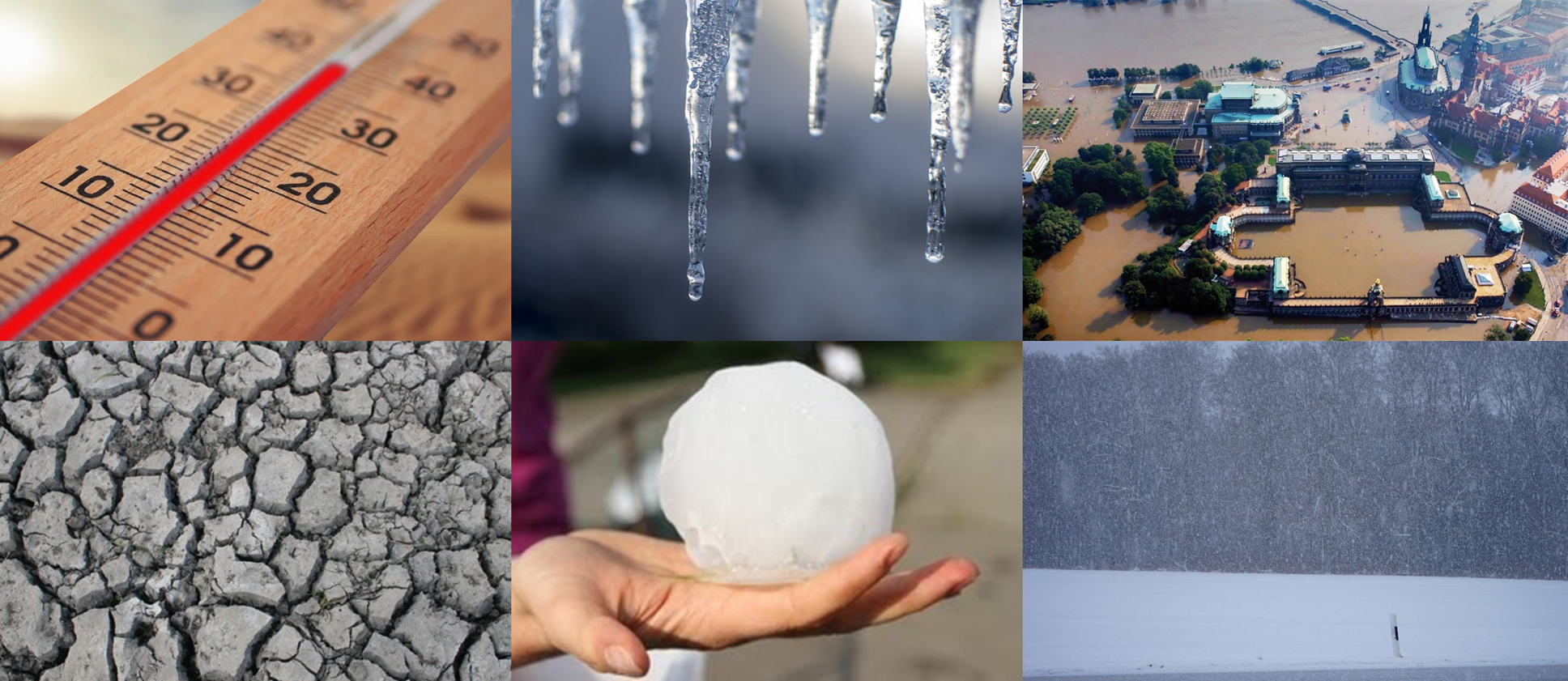Introduction
The frequent occurrence of extreme weather events in Germany and Central Europe can be shown on the basis of the recent history: In summer 2021, Germany and Central Europe were hit by various extreme events within a short time period. At the end of June, heavy rain and hail occurred particularly in Baden-Württemberg in conjunction with severe thunderstorms, resulting in many local floods and flash floods, and in mid-July, long-lasting intense precipitation in North Rhine-Westphalia and Rhineland-Palatinate led to a severe flood disaster that claimed well over 100 lives (Schäfer et al., 2021). In addition, a heat wave with record temperatures occurred in Scandinavia at the beginning of July.
In Germany, natural catastrophes involving an economic loss of around 29 billion euros occurred between 1950 and 2013 (EM-DAT; Kreibich et al., 2014). This can be attributed to different types of events: About half of all economic loss was triggered by floods, closely followed by storm damage. Heat waves, on the other hand, were mainly responsible for fatalities.
The occurrence of several extreme events within a short time period hits a society particularly severely. Furthermore, for insurers, the occurrence of several events within a year is more expensive than a single event of the same loss amount, since the net impact also depends on the number of distinct loss events (Vitolo et al., 2009). Moreover, catastrophe and risk models traditionally assume a constant time interval between extreme events, which leads to an underestimation of temporal (serial) clustering, i.e., clustered occurrence, and hence risk (Vitolo et al., 2009). An investigation into the causes of this combined occurrence and a forecast for the future is therefore highly relevant and the subject of this project.
Scientific Background
The frequency of various extreme events such as heat waves, severe frost episodes, winter storms, thunderstorms, and flood-related heavy precipitation is largely determined by the location and characteristics of large-scale circulation patterns (e.g. teleconnections). Positive phases of the North Atlantic Oscillation (NAO), for example, are associated with an increased storm activity in Central Europe during the winter months (Donat et al., 2010). In contrast, negative phases in summer lead to an increased thunderstorm activity (Piper and Kunz, 2017). Furthermore, if certain circulation patterns and weather situations or regimes are persistent, corresponding weather extremes accumulate over periods of days up to several months (serial clustering; Vitolo et al., (2009)). Thus, both the storm series of 1990 (Daria, Vivian, Wiebke) and 1999 (Lothar, Anatol, Martin) and the thunderstorm episodes of 2016 (including flash floods in Braunsbach and Simbach) and 2018 (Piper et al., 2016; Mohr et al., 2020) were expressions of such serial clustering.
If teleconnections are particularly pronounced or certain weather regimes are dominant in a year, this can lead to an extraordinary frequency of different weather extremes with corresponding impacts on society and the environment – as in 2013 with the succession of a pronounced heat wave, flooding on the Elbe and Danube rivers, and severe hailstorms (Andreas). However, the temporally clustered occurrence of different extreme events as a result of dominant large-scale circulation patterns has been insufficiently researched so far. Therefore, this project investigates how certain teleconnection patterns and flow configurations as well as weather regimes persisting over a longer period of time affect this combined frequency of different weather extremes during the course of the year, and whether changes due to climate change can be observed in the long-term.
The project Serial clustering of extreme weather events in Central Europe is funded by the Stiftung Umwelt und Schadenvorsorge (Foundation for Environment and Loss Prevention), which regularly awards grants in the field of environmental and climate research. The current scientific work program is focused on extreme weather and its interactions with the environment, society, and economy. One topic within this scientific work program is being researched at Institute of Meteorology and Climate Research (IMK-TRO) in the working group Atmospheric Risks and in association with CEDIM.

References
Donat, M. G., G. C. Leckebusch, J. G. Pinto, U. Ulbrich (2010): Examination of wind storms over Central Europe with respect to circulation weather types and NAO phases. In: International Journal of Climatology 30(9):1289–1300.
Kreibich, H., P. Bubeck, M. Kunz, H. Mahlke, S. Parolai, B. Khazai, J. Daniell, T. Lakes, K. Schröter (2014): A review of multiple natural hazards and risks in Germany. In: Natural Hazards 74(3):2279–2304.
Mohr, S., Wilhelm, J., Wandel, J., Kunz, M., Portmann, R., Punge, H. J., Schmidberger, Quinting, J. F., M., Grams, C. (2020): The role of large-scale dynamics in an exceptional sequence of severe thunderstorms in Europe May/June 2018. In: Weather Clim. Dynam. 1:325–348, doi:10.5194/wcd-1-325-2020.
Piper D., M. Kunz, F. Ehmele, S. Mohr, B. Mühr, A. Kron, J. Daniell (2016): Exceptional sequence of severe thunderstorms and related flash floods in May and June 2016 in Germany. Part I: Meteorological background. In: Nat. Hazards Earth Syst. Sci., 16:2835–2850.
Piper, D., M. Kunz (2017): Spatiotemporal variability of lightning activity in Europe and the relation to the North Atlantic Oscillation teleconnection pattern. In: Nat. Hazards Eart Syst. Sci. 17:1319–1336.
Schäfer, A., Mühr, B., Daniell, J., Ehret, U., Ehmele, F., Küpfer, K., Brand, j., Wisotzky, C. Skapski, J., Rentz, L., Mohr, S., Kunz, M. (2021): CEDIM Forensic Disaster Analysis "Hochwasser Mitteleuropa, Juni 2021 (Deutschland)" Report Nr. 1, Center for Disaster Management and Risk Reduction Technology, Karlsruhe, Deutschland, doi:10.5445/IR/1000135730.
Vitolo, R., D. B. Stephenson, I. M. Cook, K. Mitchell-Wallace (2009): Serial clustering of intense European storms. In: Metorologische Zeitschrift 18:411–424.

